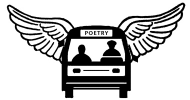It’s been forty-two years since Ken Kesey drove the bus named Further across the country, proving that not all writers are pale recluses afraid to leave their apartments. Finally, we have reached the next generation of literary bus proselytizers. On September 2, Seattle’s Wave Books commences their nationwide Poetry Bus Tour, a prospect they are calling “the biggest literary event of 2006” and “the most ambitious poetry tour ever attempted.” These are not overstatements. By any standards, especially those of poetry, the figures involved are ambitious. Over a period of fifty days, a total of 200+ poets will travel through forty-eight cities and across 12,646 miles of North America. The bus, a forty-foot Biodiesel MCI, sleeps groups of thirty-eight poets at a time, and will bring nationally read names like Eileen Myles (“The rock star of modern poetry”—Bust) and Noelle Kocot (“Rilke with a sense of humor”—Village Voice) to read alongside local poets across the United States and Canada. Filmmakers and journalists will also accompany the bus, documenting the performances, the busriding, and the backstage experience. Since most touring bands deteriorate before the fifty-day mark, it should be interesting to watch the effects of close-quartered, extended touring on some of America’s most important young poets.
Though Wave is releasing a handful of new collections in September, the tour is meant to function less as a promotional tour—most of the poets are not associated with the press—and more as a step toward developing a larger poetry community. At the head of the bus will be Joshua Beckman, a poet himself who, before becoming Wave’s editor (and tour coordinator), lived out of a teepee, selling vegetables at a farmstand in Massachusetts. “The bus tour,” Beckman says, “is attempting to create an environment in which poets from over a huge geographical area have meaningful engagement—not only through reading and listening, but collaborating.” He envisions the tour as a way to give faces to the names that appear in journals, online zines, blogs, and anthologies. He wants to establish “real human contact and a genuine presence” in both major cities (NYC, Los Angeles, Boston) and smaller towns (Marfa, Orfordville) where poetry culture is less widely available.
The Bus will also initiate a wave of unorthodox readings, with events held at prisons, arts festivals (Seattle’s Bumbershoot), a Naval Academy, inside art installations (James Turrell’s Roden Crater project), and at various historical landmarks, including the Green Mill in Chicago, the birthplace of Slam poetry.
While the Poetry Bus may sound overly ambitious, large poetry tours are not a new enterprise for Wave. A few years ago (when the press was still Verse), Beckman and fellow Wave-published poet Matthew Rohrer toured the country with a unique brand of improvisational readings, visiting nineteen states in thirty days. Every night, the audiences called out subjects like “hillbillies” or “spy satellites” and the two poets improvised, alternating phrase-by-phrase (sometimes word-by-word) until they arrived at tight, fully-realized poems.
I know a hillbilly (Matthew)
And I love a hillbilly (Joshua)
But they’re not the same (Matthew)
In the same way that improvisational poetry carries an in-the-moment urgency at every reading, the organizers of the Poetry Bus Tour hope the new events will create an immediacy that is not usually associated with poetry. Across the country, from Laramie to New York, people will have direct, personal access to the happenings of contemporary literature. The already knowledgeable can meet the poets they’ve been reading for years, establish collaborative relationships, and start their own reading tours, while newcomers will have the opportunity to break open the seal of modern poetry, which can sometimes seem locked tight against them. If poets in the country receive the bus tour phenomena not just as a single, isolated event, but as the beginning of a large-scale communal idea, it could, like Kesey’s bus tour, inspire an entire lineage of artists.





